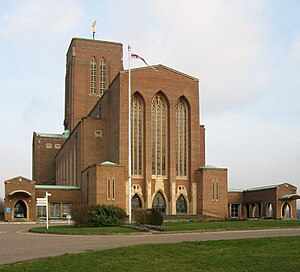Guildford Cathedral
| Guildford Cathedral | |
|---|---|
| Cathedral Church of the Holy Spirit | |
 |
|
| Coordinates: 51°14′28″N 0°35′24″W / 51.2411°N 0.5900°W | |
| Location | Guildford, Surrey |
| Country | England |
| Denomination | Church of England |
| Website | www.guildford-cathedral.org |
| History | |
| Consecrated | 1961 |
| Architecture | |
| Architect(s) | Edward Maufe |
| Style | Neo-Gothic/Art Deco |
| Years built | 1936–1961 |
| Specifications | |
| Number of towers | 1 |
| Tower height | 48.8m (160 feet) |
| Administration | |
| Diocese | Guildford (since 1927) |
| Province | Canterbury |
| Clergy | |
| Dean | Dianna Gwilliams |
| Precentor | Nicholas Thistlethwaite |
| Canon(s) | Andrew Bishop, Chaplain to the University of Surrey Julie Gittoes, Residentiary Canon |
| Archdeacon | The Archdeacon of Surrey (Residentiary Canon) |
The Cathedral Church of the Holy Spirit, Guildford is the Anglican cathedral at Guildford, Surrey, England. Designed by Sir Edward Maufe and built between 1936 and 1961, it is the seat of the Diocese of Guildford.
Guildford was made a diocese in 1927, covering most of Surrey. Work began nine years later on its cathedral, which was to be a lead centre of worship and community events venue. The diocese chose Sir Edward Maufe as its architect and the foundation stone was laid by Dr Cosmo Gordon Lang, Archbishop of Canterbury in 1936. Construction was intended to span many years to allow necessary funds to be raised, but building work had to be suspended during the Second World War. In the meantime Guildford's restored medieval Holy Trinity Church served as pro-cathedral. In 1952 Walter Boulton, who had ministered mostly in India, was made provost (head priest at the pro-cathedral and pastor of the parish), and revitalized the fund-raising for the new cathedral. The building could not be consecrated until 17 May 1961. When it was completed sufficiently for public worship, another cleric was chosen as first dean of the cathedral by the bishop, after consultation with various benefactors and influential clergy within Anglicanism.
In the 1950s a "buy a brick" scheme was used to raise funds for construction, to great success. Each brick cost 2s 6d and entitled the buyer to sign their name on the brick. The Queen and Prince Philip both signed bricks, which are on display inside the cathedral.
...
Wikipedia

